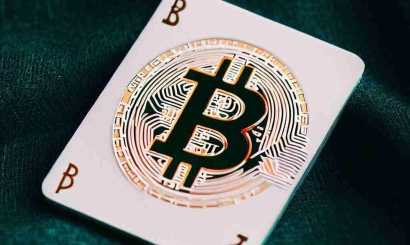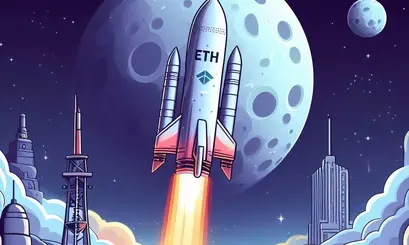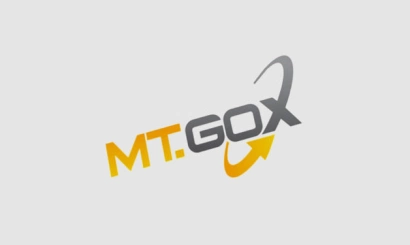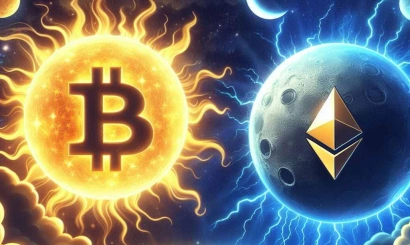Master data provider. What is Chainlink and why does the blockchain need oracles
What is Chainlink (LINK) cryptocurrency and why blockchain oracles are needed
The LINK token of the Chainlink project has surpassed Bitcoin in terms of growth and has become one of the best investments of the end of 2023 among large crypto assets. We tell you how the project is organized and what justifies the demand for its token
Bitcoin's sharp rise in late October brought the major cryptocurrency back to price levels last seen in the spring of 2022. At the same time, several major cryptoassets outperformed the market leader in terms of growth dynamics. Among them is the LINK token of the Chainlink project, which has doubled in value since the beginning of October, adding 50% to its price in a week.
Chainlink is a service for exchanging data from its own network of so-called distributed oracles. Technically, oracles are lines of program code that provide information from external sources to smart contracts that set the logic for blockchain services.
Thanks to oracles, they can take necessary data that cannot be placed directly inside the transaction blocks and track it in real-time. This could be cryptocurrency exchange rates, interest rates or, for example, weather information. Chainlink essentially acts as a supplier of this data to other projects and guarantees its authenticity and relevance.
The popular cryptocurrency aggregator CoinGecko categorizes more than 30 crypto projects with their own tokens as oracles, with a combined capitalization of over $7 billion. Chainlink is the largest of them, far ahead of its competitors. As of October 25, the LINK token is worth $11 with a market capitalization of over $6 billion.
- Successful investments
Chainlink founder Sergey Nazarov was born in Moscow in 1986 and moved to New York with his family in the 1990s. On his LinkedIn page, he indicated that for a while he taught a course on technological entrepreneurship taught by Lawrence Lenihan, a professor and CEO of FirstMark Capital, a venture capital fund. Nazarov later joined Lenihan's firm as part of a team of seven investment managers that, during his tenure, managed $2 billion in capital and committed more than $90 million in venture funding to promising startups, including Pinterest and game developer Riot Games.
Nazarov's familiarity with crypto technology dates back to 2011. Before creating Chainlink, he had already participated in profitable projects that involved crypto in one way or another, and early on he invested in bitcoin, which was worth about $30 at the time. During that period, he founded his own venture capital firm, QED Capital, which funded young tech entrepreneurs from Russia and Eastern Europe.
In 2014, Nazarov, Steve Ellis, and Ari Jules founded the SmartContract.com project, which aimed to securely connect smart contracts with various data sources and external interfaces. The idea of connecting external data to smart contracts on blockchain networks eventually led to the creation of Chainlink, Nazarov's most successful project to date.
The company Chainlink Labs, which grew out of the SmartContract.com project, is behind the development of Chainlink. In July 2017, the project sold LINK tokens through an initial coin offering (ICO), where participants were able to purchase LINK for around $0.09 per token. By the end of October 2023, when LINK is trading at $11, the return on such an investment exceeds 1000%.
The Chainlink protocol serves as a link between the blockchain and data from the outside world. Over the past few years, Chainlink has gained a foothold in the crypto industry through high-profile partnerships and integrations into various networks and organizations. Among the project's partners are Google's cloud service, the National Basketball Association (NBA), the Coinbase cryptocurrency exchange or, for example, the blockchain platform of the State Information Center of the People's Republic of China.
Chainlink, together with the SWIFT financial messaging system, is working on the possibility of using its own protocol to transfer tokens in the interbank network through any blockchain ecosystem. For SWIFT, this has become interesting because instead of just exchanging messages, the system will also be able to perform settlements, not directly, but through the blockchain. Usually SWIFT just delivers information, for example, from banks, and the banks themselves are engaged in making payments.
- A token in demand
Smart contracts themselves cannot access data outside the blockchain, so Chainlink helps them by collecting data from multiple external sources, (oracles) and sending it back to the blockchain. This approach is considered more reliable than going to a single oracle, which controls the data individually. If, for example, a smart contract needs the exact price of a cryptocurrency, Chainlink allows its decentralized network of price oracles to find a consensus on the current rate, which it transmits the data on demand.
To aggregate the data from such oracles, Chainlink requires the nodes (nodes) in the network, operated by individuals or companies, to agree on the accuracy of the data before making it available for use by smart contracts. Operators of nodes that provide and verify data submitted to smart contracts are rewarded in LINK tokens.
The native asset of the Chainlink network exists as an ERC-20 standard token on the Ethereum blockchain. To earn tokens, node operators must also place a certain amount of tokens in staking, with the nodes with the highest share having a greater chance of being rewarded.
Chainlink does not have its own blockchain. The protocol works with Ethereum Virtual Machine (EVM) based blockchains capable of executing smart contracts, such as Ethereum, Binance Smart Chain, Polygon, Avalanche or Fantom, but also supports other networks such as Solana.
The usefulness of the LINK token and the critical function that Chainlink performs by linking smart contracts to real data has led to an increase in demand for and value of the LINK token, especially as the field of decentralized finance (DeFi) and other blockchain applications evolve.
Nazarov himself emphasizes that a network of distributed oracles is not the same as blockchain and that few people yet truly understand the potential of his project. He says he wants people to realize that his team is working to create a secure and reliable system that can process "tens of trillions of dollars worth of transactions." As it becomes more widely implemented, everyone will realize what it is.
- FTX is in talks to reopen
- Possible inflow of funds into bitcoin-ETF estimated at $39 bln over three years
- Chainalysis: North America leads in cryptocurrency usage
- Matrixport predicted bitcoin growth in 2023 to $45 thousand.
- Single Slot GeForce RTX 4060 Ti 16GB
- In the name of the industry. Why Ripple Labs is openly confronting the SEC
- SEC chief says crypto industry full of fraud and con artists




_410x245_00e.webp)


